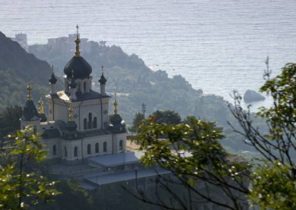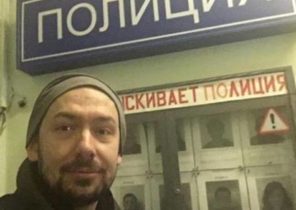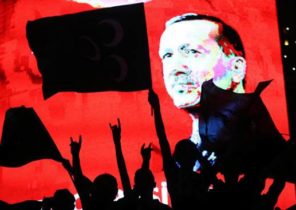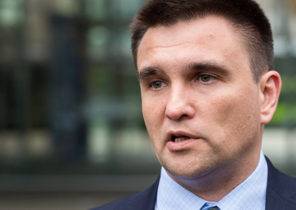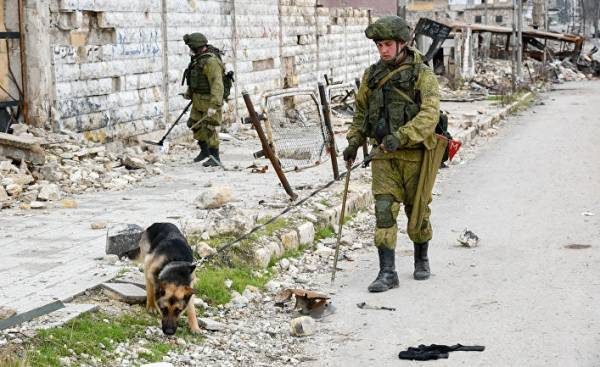
Russian-Turkish relations suffered from the fact that these countries have had different goals in Syria. The decision of Russia to carry out direct intervention taken at the end of September 2015, have challenged the interests of Turkey. At the beginning of the Russian military operation task, apparently, was to defend key areas of the Assad regime, including the coast of Latakia and the road to Damascus. Turkey, unlike Russia, has for several years helped the opposition to expand its controlled territory up to the coast, desiring to strengthen the opposition forces in the struggle against the regime. This confrontation caused a serious deterioration in relations with Russia and contributed to the Turkish defeat in Syria.
The author studied the military actions of the Turks, Kurds, Americans and Russians in the Northern part of Aleppo, in the period from July 2014 to March 2017. He collected data indicate that their own actions to counter the escalation of the Russian and Kurdish troops launched when Turkey challenged them during the operation “shield of the Euphrates” that was carried out outside of Turkey in the Syrian territory. Russia maintains escalation advantage in relation to Turkey, and has repeatedly demonstrated its ability to leverage the self-defense forces of Syrian Kurds (YPG) as a counter-escalation funds, nullifying all the Turkish efforts to regain leverage over Moscow. This dynamic has been a hallmark of the Syrian conflict after the Russian military intervention.
Almost throughout the civil war in Syria, the Turkish air force carried out sorties and patrols, holding the aircraft of Assad on a narrow piece of land along the border. The Turks wanted to protect supply routes leading through a’zaz in Aleppo through deterrence and coercion. Starting in October 2015, Russia has thrown down a direct challenge to Turkey of its actions. In one incident, which was an omen of future developments, the Turkish air force in mid-October of 2015 has hit the Russian multifunctional unmanned complex “Orlan-10” in the border area in the village of Kilis. A month later, on 24 November, the Turkish F-16, probably, have received additional guidance and opened fire outside of line of sight, he shot down a Russian su-24 bomber when the 17 seconds accidentally flew into Turkish airspace. This case occurred in the mountains of Latakia, where enjoying Turkish support for opposition forces had intended to go to the coast.
Because of this incident, Russia has concentrated its efforts on how to cut off Turkey from Aleppo. According to expert on Russia Michael Kofman (Kofman Michael), Russia decided to “form a part of the Syrian military opposition on the ground, destroying those she did not want to see at the negotiating table”. At the end of November the Russians had expanded the air strikes to include a corridor a’zaz-Aleppo. These strikes are given at once three results: 1) the Turkish air force lost the opportunity to make sorties, and the Russians began to strike in this area as an integral part of anti-ISIS coalition; 2) were disrupted U.S.-Turkish plans to use trained rebels to block pockets of resistance in Manbij; 3) the Russian aviation and Kurdish self-defense forces squeezed Ankara from the Northern part of Aleppo. In early February of 2016, all three interrelated objectives have been achieved, when for 10 days was cut the Turkish supply route from Azaz to Aleppo and the Kurds moved forward and took the airbase Minag and tel Rifat. Only after completing these tasks, Russia February 16, 2016, has agreed to a cease-fire.
It allowed Turkey to refocus its actions in Syria to defeat the “Islamic state” (banned in Russia organization — approx. transl.). Deployed along the border, the Turkish artillery began to shell the positions of ISIS by supporting the rebels surrounded at the turn of Marie. Despite American support, the rebel groups were too weak and fragmented, due to which the militants began to counterattack. The struggle for control over small and sparsely populated villages along the Turkish border went on with varying success for several months, after which the United States has decided to use to capture Manuja multinational military coalition called the Syrian democratic forces, which was dominated by the Kurdish people’s protection Units YPG. The offensive began at the end of may 2016, and by early June, Manbij was besieged.
After a failed coup attempt in July 2016, the Turkish Party of justice and development party (AKP) held a cleansing in the ranks of the opposition, who opposed intervention in Syria. Ankara then tried to win Moscow’s consent for the operation “shield of the Euphrates”. At the end of July the troops of the Syrian regime, with the assistance of Russian advisers and aircraft surrounded Aleppo. Turkey and the United States began negotiations with Moscow on the evacuation of people from the Eastern part of Aleppo and Ankara have completed this process, having signed with Russia an agreement. On 9 August, President Erdogan met with Putin in St. Petersburg. Looking back, I understand that most likely, the two leaders agreed on the elimination of conflict situations, which allowed the Turks to invade. Five days later, on 14 August, the Syrian democratic forces took Manbij. This caused Ankara’s concern, as this group could continue to advance at Jerablus and al-Bab. Capturing the past, the Kurds have closed to their territory along the Turkish-Syrian border.
24 August, the Turkish troops crossed the border without encountering serious resistance. About this operation, spoke contemptuously, saying that Turkey traded Aleppo al-Bab. But this is impossible to explain the actions of Russian throughout the military campaign, because they tried to do everything to Ankara created a threat to their major interests in Aleppo. Moscow also continued to use the YPG forces as a counter-escalation tools against Turkey. The first incident occurred in mid-October, when the Turkish forces and their surrogates engaged in battle with the Kurdish South of tel Rifat, located 25 kilometers West of El-Baba. Then on November 24, the Iranian drone, most likely supporting the Syrian armed forces or associated militia, attacked the Turkish troops, which killed three soldiers. The next day, President Erdogan spoke to Putin on the phone, and the Minister of foreign Affairs Mevlut Cavusoglu 26 Nov visited Tehran. Fighting in the area subsided in the day when Erdogan spoke to Putin. Shortly thereafter, a small detachment of the Kurdish militia, interacting with the Syrian regime, established in the area of contact with the Syrian democratic forces and began to act as a buffer.
Roughly the same happened in February 2017 in Manbij. When in mid-November, fell al-Bab, the allies of the Turks began to attack the positions of Syrian democratic forces to the West of al-ARIMA. A month earlier, Ankara tried to prevent the capture of the village by units of the Syrian democratic forces, but because of those who fought on the side of Turkey the allies were weak, they could not fight simultaneously on several fronts. Turkish artillery, usually compensate for the shortcomings of the land forces of its allies, failed to prevent the fall of al-ARIMA. When supported by the Turkey troops in late February, took al-Bab, they attacked positions of the Syrian democratic forces to the West of al-ARIMA. In the ensuing clashes, the units of SDS left several villages. In this regard, the Syrian democratic forces went on a counter-escalation. On March 1, Russia, the Syrian regime and the SBC agreed to form a small strip of defense along the Western ledge held by units of VTS areas.
From the inception of this agreement, used a tactic similar to that used South of tel Rifat, where SDS and the militia of the Syrian regime acted together. It is possible that some groups of SDS just wore the uniform of the Syrian regime. The next day after Turkey convened a trilateral meeting with the participation of Moscow and Washington, Russia has stepped up its efforts in this area. It happened on March 8th. 9 March President Erdogan went to Moscow on a two-day summit. On March 10, when he returned to Ankara, all the fighting with Syria for the Turks controlled the territory ceased. Prior to that, Ankara has constantly inflicted artillery strikes on tel Rifat, air force base, Minag and Manbij. Most likely, she did it in order to weaken the defense YPG and SDS, and to create conditions for the development of his own offensive.
The tripartite summit and the visit to Moscow has not brought Turkey any good. Turkey continued to fight on the Western outskirts of al-ARIMA, and because of this, Russia has decided to increase its presence in the area. In the end this put an end to the hostilities. Moreover, the Russian government has kept a part of economic sanctions against Turkey, which was introduced in December 2015 after the destruction of the Russian su-24. It seems that Turkey 16 March 2017 has imposed retaliatory sanctions against Russia, imposing a duty on imported Russian wheat. Ankara denies that these measures are formal sanctions, however, until mid-March, Russia has supplied the wheat duty free.
Finally, on March 20, the Russian military announced the establishment of a military camp held in the Kurdish self-defense ‘ Afrīn to monitor compliance with the truce reached with Turkey in Astana a few months earlier. The truce was broken, but the Russian statements about this arrangement, as well as information about the arrival of Russian troops in the area contrary to the stance of Ankara, which has long been declares that the right to strike at YPG, because it considers it a terrorist organization. The recent actions of Russia in the North of Aleppo, Turkey was cornered.
The sequence of events clearly indicates that Moscow and Ankara in Syria opposing goals, and now Russia and YPG support a mutually beneficial relationship, opposing Turkey. Turkey still has opportunity to exert pressure on Russia in Syria. Ankara trains on its territory of the rebels, who are fighting together with her proteges in the North of Aleppo. Turkey may just send these people to other parts of Idlib or Hama, putting before them the task of attacking the position of the regime. However, the events that occurred from November 2015 to February 2017, clearly indicate that Russia has in Syria, escalation advantage over Turkey. Moreover, Kurdish self-defense forces in Afrin who are well armed and enjoy the unconcealed Russian support can move South and capture the border crossing Reyhanli / Bab al-Hawa. Russia could easily justify such actions need to defeat the Syrian branch of “al-Qaeda”, which is active in Idlib. To prevent this, Ankara will have to shoot at Russian soldiers, and that could lead to clashes at the border, and here Turkey is the weak side.
But Russia remains Turkey a valuable tool that allows it to exert pressure on the United States. Ankara is against American support of the Syrian democratic forces, as it strengthens the YPG forces along the northeast border. Turkey through Moscow trying to send US a signal that it has different options, not just the Turkish-American Alliance, ensuring the safety of Turkey in the framework of NATO. The events in Syria is clearly contradictory to this. Russia is not an ally of Turkey. It uses all its available means to force the opposition to serve their ultimate objectives, which consist in the peaceful settlement on Russian terms, which is clearly contrary to Turkish interests. Turkey has a poor selection of funds to change these dynamics, especially due to the fact that the United States in the North-East of Syria is its preferred partner in the SDS. She has fewer opportunities to change the trajectory of these two major powers.
Aaron Stein is a senior researcher of the middle East center. Rafik Hariri.
